None of these are new rules, they were all previously in place for non-EU citizens and people travelling to France from outside the EU, but they now apply to Britons who had previously enjoyed a more relaxed travel experience thanks to European freedom of movement and their status as citizens of an EU country.
So far, enforcement of all of these rules seems to vary and not everything is checked on every crossing, but border guards and customs officials have been stepping up checks on arrivals from the UK so it is best to be prepared.
Passport stamping
The end of European freedom of movement for Brits has meant that UK nationals join Americans, Canadians, Australians and other non-EU citizens in the world of visas and the 90-day rule.
You can find a full explanation of the 90-day rule HERE, but in brief Brits can only spend 90 days out of every 180 in the EU without getting a visa.
And in order to keep track of this, your passport may be stamped as you enter France.
People who are residents of France should not be stamped, but you will need to remember to show your visa or residency card at the border along with your passport. Here’s what to do if you are a resident and your passport is stamped.
Picnic confiscation
When it left the EU, the British government also opted to leave the single market and the EU-wide protocols on health standards and animal welfare – and this has an impact on any food you might try to bring into France.
Whether it’s sandwiches for the journey or bringing in British treats like Bovril for your European friends and neighbours, there is now a long list of items that cannot be brought in.
READ ALSO Bovril, tea and hand sandwiches – what can you bring from the UK into an EU country?
This covers all animal products and you can find the full list HERE.
Pet passports
Your pet too has lost his or her status within the EU, so their European pet passport is no longer valid.
If you are bringing a cat, dog or ferret into the EU you now need to get an Animal Health Certificate for each trip, unless you live in France in which case you need to get a French pet passport.
Full details of how that works HERE.
Plasterboard, plants and power tools
If you are bringing items worth more than €430 into the EU you may now have to pay duty on them.
People moving house have an exemption – but need to provide a detailed itinerary for customs officers plus proof of their move – but people who just want to bring over items such as DIY materials for a second home may face steep bills in customs duties if they are stopped at the ports.
READ ALSO Do you have to pay duty if you bring furniture to France?
And keen gardeners may want to note that bringing over flowers, plants and bulbs for your garden is now outlawed under the same sanitary and phyto-sanitary rules the affect your ham sandwiches.
Proof of accommodation
Non-EU citizens entering France can be asked to provide proof of where they are staying, as well as insurance and their financial means.
This not always strictly enforced, but arrivals can be asked to provide proof of a booking in a hotel, gîte, B&B or similar or alternative proof of accommodation such as proof of address for second-home owners.
Those coming to stay with friends or family can be asked to provide a certificate known as an attestation d’acceuil, or alternatively proof that they have a minimum of €120 for each day of their stay.
And . . . Pandemic paperwork
Hopefully a temporary change, but remember that France currently has strict entry requirements from the UK, with arrivals needing to present a form stating that their reasons for visiting are essential, an undertaking to quarantine for seven days and a negative Covid test taken within the previous 48 hours.
READ ALSO Everything you need to know about travel between France and the UK



 Please whitelist us to continue reading.
Please whitelist us to continue reading.
Regarding the 430 euro limit on goods or gifts, how do customs officials distinguish these from holiday luggage and personal effects? Just a phone will exceed the limit! What are the guidelines? Very important for caravans and motorhomes, and in my case a cruising yacht, which literally contain everything including the kitchen sink! How do border officials decide which stuff on board is to be counted as imported goods or gifts? Tough question but I know someone out there knows the answer! Thanks 🙂
If you have had your both vaccines are you not exempt from quarantine?